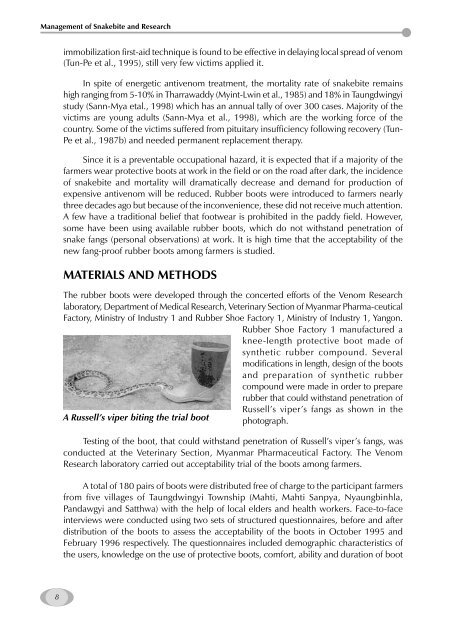Management of Snakebite and Research Management of Snakebite ...
Management of Snakebite and Research Management of Snakebite ...
Management of Snakebite and Research Management of Snakebite ...
Create successful ePaper yourself
Turn your PDF publications into a flip-book with our unique Google optimized e-Paper software.
<strong>Management</strong> <strong>of</strong> <strong>Snakebite</strong> <strong>and</strong> <strong>Research</strong><br />
8<br />
immobilization first-aid technique is found to be effective in delaying local spread <strong>of</strong> venom<br />
(Tun-Pe et al., 1995), still very few victims applied it.<br />
In spite <strong>of</strong> energetic antivenom treatment, the mortality rate <strong>of</strong> snakebite remains<br />
high ranging from 5-10% in Tharrawaddy (Myint-Lwin et al., 1985) <strong>and</strong> 18% in Taungdwingyi<br />
study (Sann-Mya etal., 1998) which has an annual tally <strong>of</strong> over 300 cases. Majority <strong>of</strong> the<br />
victims are young adults (Sann-Mya et al., 1998), which are the working force <strong>of</strong> the<br />
country. Some <strong>of</strong> the victims suffered from pituitary insufficiency following recovery (Tun-<br />
Pe et al., 1987b) <strong>and</strong> needed permanent replacement therapy.<br />
Since it is a preventable occupational hazard, it is expected that if a majority <strong>of</strong> the<br />
farmers wear protective boots at work in the field or on the road after dark, the incidence<br />
<strong>of</strong> snakebite <strong>and</strong> mortality will dramatically decrease <strong>and</strong> dem<strong>and</strong> for production <strong>of</strong><br />
expensive antivenom will be reduced. Rubber boots were introduced to farmers nearly<br />
three decades ago but because <strong>of</strong> the inconvenience, these did not receive much attention.<br />
A few have a traditional belief that footwear is prohibited in the paddy field. However,<br />
some have been using available rubber boots, which do not withst<strong>and</strong> penetration <strong>of</strong><br />
snake fangs (personal observations) at work. It is high time that the acceptability <strong>of</strong> the<br />
new fang-pro<strong>of</strong> rubber boots among farmers is studied.<br />
MATERIALS AND METHODS<br />
The rubber boots were developed through the concerted efforts <strong>of</strong> the Venom <strong>Research</strong><br />
laboratory, Department <strong>of</strong> Medical <strong>Research</strong>, Veterinary Section <strong>of</strong> Myanmar Pharma-ceutical<br />
Factory, Ministry <strong>of</strong> Industry 1 <strong>and</strong> Rubber Shoe Factory 1, Ministry <strong>of</strong> Industry 1, Yangon.<br />
Rubber Shoe Factory 1 manufactured a<br />
knee-length protective boot made <strong>of</strong><br />
synthetic rubber compound. Several<br />
modifications in length, design <strong>of</strong> the boots<br />
<strong>and</strong> preparation <strong>of</strong> synthetic rubber<br />
compound were made in order to prepare<br />
rubber that could withst<strong>and</strong> penetration <strong>of</strong><br />
Russell’s viper’s fangs as shown in the<br />
A Russell’s viper biting the trial boot<br />
photograph.<br />
Testing <strong>of</strong> the boot, that could withst<strong>and</strong> penetration <strong>of</strong> Russell’s viper’s fangs, was<br />
conducted at the Veterinary Section, Myanmar Pharmaceutical Factory. The Venom<br />
<strong>Research</strong> laboratory carried out acceptability trial <strong>of</strong> the boots among farmers.<br />
A total <strong>of</strong> 180 pairs <strong>of</strong> boots were distributed free <strong>of</strong> charge to the participant farmers<br />
from five villages <strong>of</strong> Taungdwingyi Township (Mahti, Mahti Sanpya, Nyaungbinhla,<br />
P<strong>and</strong>awgyi <strong>and</strong> Satthwa) with the help <strong>of</strong> local elders <strong>and</strong> health workers. Face-to-face<br />
interviews were conducted using two sets <strong>of</strong> structured questionnaires, before <strong>and</strong> after<br />
distribution <strong>of</strong> the boots to assess the acceptability <strong>of</strong> the boots in October 1995 <strong>and</strong><br />
February 1996 respectively. The questionnaires included demographic characteristics <strong>of</strong><br />
the users, knowledge on the use <strong>of</strong> protective boots, comfort, ability <strong>and</strong> duration <strong>of</strong> boot









